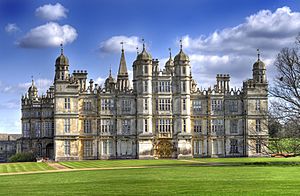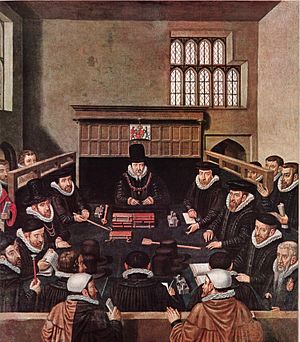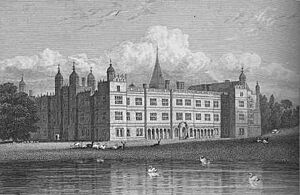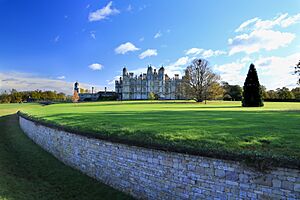Burghley House facts for kids
Quick facts for kids Burghley House |
|
|---|---|

The façade of Burghley House
|
|
| Type | Prodigy house |
| Location | Cambridgeshire |
| Built | 1555–1587 |
| Architect | William Cecil, 1st Baron Burghley |
| Architectural style(s) | Elizabethan |
| Website | burghley.co.uk |
|
Listed Building – Grade I
|
|
| Official name: Burghley House | |
| Designated | 16 January 1956 |
| Reference no. | 1127501 |
|
Listed Building – Grade I
|
|
| Official name: Stables with forecourt railings and service wings and servants wing, brewery and porters lodge | |
| Designated | 16 January 1956 |
| Reference no. | 1127502 |
|
Listed Building – Grade I
|
|
| Official name: The Orangery | |
| Designated | 16 January 1956 |
| Reference no. | 1127503 |
|
Listed Building – Grade I
|
|
| Official name: North Forecourt Area Railings and Gates at Burghley House | |
| Designated | 16 January 1956 |
| Reference no. | 1331234 |
| Official name: Burghley House | |
| Designated | 16 January 1985 |
| Reference no. | 1000359 |
| Lua error in Module:Location_map at line 420: attempt to index field 'wikibase' (a nil value). | |
Burghley House is a huge, beautiful country house built over 400 years ago. It's located near Stamford in England. This amazing house is a top example of an "Elizabethan prodigy house," which means it was a very grand home built during the time of Queen Elizabeth I. The Cecil family, who built it, still lives there today! It's also a Grade I listed building, meaning it's super important historically.
From the outside, Burghley House still looks much like it did when it was first built. However, many of the rooms inside were updated before the year 1800. The house is open to visitors during certain times of the year. You can explore many grand and beautifully decorated rooms. The large park around the house was designed by a famous landscape architect named Capability Brown.
Burghley House is located right on the edge of Cambridgeshire. It's about 1.5 kilometers (0.9 miles) south of Stamford and 16 kilometers (10 miles) northwest of Peterborough city centre. Today, the house is looked after by the Burghley House Preservation Trust, which is still managed by the Cecil family.
Contents
History of Burghley House
Burghley House was built for Sir William Cecil, who later became the 1st Baron Burghley. He was a very important advisor to Queen Elizabeth I of England, serving as her Lord High Treasurer. The house was built between 1555 and 1587. It cost about £21,000 at the time, which was a huge amount of money back then! The design was inspired by parts of Richmond Palace.
After Sir William Cecil, his family continued to live in the house. His descendants became Earls, and then, after 1801, Marquesses of Exeter. Since 1961, the house has been owned by a special trust set up by the family to make sure it is preserved.
Victoria Leatham, who is an expert in old items and a TV personality, managed the house from 1982 to 2007. Her father, David Cecil, 6th Marquess of Exeter, was an Olympic athlete and a Member of Parliament. There's even an "Olympic corridor" in the house to remember him. Today, Victoria's daughter, Miranda Rock, is the main trustee who lives at Burghley and helps run it.
Architecture and Design
Burghley House is a fantastic example of Elizabethan architecture from the 1500s. It shows off amazing stonework and careful design. Its grand size reflected how important its owner, Sir William Cecil, was. The house also shows the wealth from the wool trade that the Cecil family had.
The main part of the house has 35 large rooms on the ground and first floors. There are also more than 80 smaller rooms, along with many hallways, bathrooms, and service areas.
In the 1600s, the open walkways around the ground floor were enclosed. The house was originally built in the shape of the letter "E" to honor Queen Elizabeth I. However, one part, the northwest wing, was later removed. This happened when Brownlow Cecil, 9th Earl of Exeter owned the house. He worked with the famous landscape designer Capability Brown to make the park even better. The northwest wing was taken down to create more beautiful views of the new parkland.
The "Hell Staircase" and the "Heaven Room" are famous for their amazing ceiling paintings. These were done by an artist named Antonio Verrio between 1697 and 1699. The walls of the "Hell Staircase" were painted about a century later by Thomas Stothard. Another artist, Louis Laguerre, decorated the Bow Room with wall and ceiling paintings.
Art Collection at Burghley
Even though some important artworks were sold in the 1960s due to taxes, the art collection at Burghley House is still very large and mostly complete. The house displays hundreds of paintings. Many of these are from the 1600s and were bought in Italy by John Cecil, 5th Earl of Exeter (who lived around 1648–1700) and Brownlow Cecil, 9th Earl of Exeter (1725–1793). These two visited Italy eight times and brought back many artworks. John Cecil alone bought 300 pieces of art during his 22 years at Burghley.
The chapel inside the house has a large altarpiece painting by Paolo Veronese and his team. There are also two big paintings by Johann Carl Loth, a German artist. The collection includes seven works by Luca Giordano, including a painting of himself.
In the Pagoda Room, you can see portraits of the Cecil family, Queen Elizabeth I, King Henry VIII, and Oliver Cromwell. Many of the house's beautifully painted walls and ceilings were created by Antonio Verrio. The Billiard Room has six oval portraits of members of the "Order of Little Bedlam," which was the 5th Earl's drinking club.
The house also has a very important collection of Japanese export porcelain. What makes it special is that many pieces still in the house, and others that were sold, can be matched to an inventory from 1688. This makes them some of the earliest recorded pieces of Japanese porcelain in Europe that can be traced so clearly.
You can also see many beautiful pieces of furniture, including some made by famous 18th-century cabinet makers like Ince and Mayhew. There are also collections of silver, tapestries, and other types of porcelain. Much of this is on display in the main rooms. A new "Treasury" area in the Brewhouse has changing exhibitions that highlight different parts of the collections.
Parkland and Gardens
The long paths and tree-lined avenues in the park were all designed by Capability Brown between 1755 and 1779. He made sure to keep older trees and plants that were already there, some of which dated back to the 1500s or even earlier.
Brown also created the park's large, man-made lake between 1775 and 1780. He found a special waterproof clay in the ground, which allowed him to make the original small pond much bigger. The lake now covers about 105,000 square meters (26 acres) and is designed to look like a winding river. Brown also designed the Lion Bridge in 1778, which cost £1,050. He was paid a total of £23,000 for all his park designs at Burghley. To keep Brown's landscape beautiful, 30,000 new trees were planted between 2012 and 2016.
Originally, lion statues made of a special material called Coade stone were used for decoration. When these wore out from the weather, new stone lions were made by a local stonemason, Herbert Gilbert, in 1844. Queen Victoria and Prince Albert even planted two trees to remember their visit to Burghley.
Besides the yearly Burghley Horse Trials, the park is also used for the "Burghley Run" for Stamford School and a yearly meeting for the Cambridge University Draghounds.
Recently, a sculpture garden was started around the old ice house. In 2007, a "garden of surprises" was created. It uses old ideas like water traps, shell caves, and a mirror maze, but with a modern twist. The Burghley House trust has also asked famous artists to create new artworks for the grounds.
The parkland and gardens of Burghley House are listed as Grade II* on the Register of Historic Parks and Gardens, showing their historical importance.
Burghley House Today
Burghley House is a Grade I listed building, and its north courtyard and gate are also listed separately as Grade I. This means they are all very important historical structures. The house and its gardens are described as having "C19 and C20 formal gardens and pleasure grounds, developed from those originally designed by Lancelot Brown, surrounded by a park of C16 origins for which Brown provided extensive plans between 1754 and 1777."
Since 2007, Miranda Rock, who is the director of the Burghley House Preservation Trust, has lived in the house with her family. She is the granddaughter of the 6th Marquess of Exeter. Before the COVID-19 pandemic, the number of visitors to Burghley House had almost doubled during Miranda Rock's time there, reaching 110,000 visitors each year.
One interesting and unusual feature in the house's kitchen is the presence of fourteen green sea turtle skulls on the wall. These are likely leftovers from a Victorian-era fancy dish called "turtle soup." This soup was very popular with the upper classes and led to a big drop in green sea turtle numbers before it eventually went out of style.
Filming Location
Burghley House has been a popular location for many films and television shows. Some of these include:
- Treasure Houses of Britain (1985)
- Middlemarch (1994)
- Antiques Roadshow (1998, 2009)
- The Golden Bowl (2000)
- Bleak House (2005)
- Pride & Prejudice (2005)
- The Da Vinci Code (2006)
- Castle in the Country (2006)
- Elizabeth: The Golden Age (2007)
- How We Built Britain (2007)
- Climbing Great Buildings (2010)
- Royal Upstairs Downstairs (2011)
- Housefull 2: The Dirty Dozen (2012)
- The Crown (2016)
- Top Gear (2018)
- Mortimer & Whitehouse: Gone Fishing (2021)
- The Flash (2023)
- Frankenstein (2025)
Images for kids
See also
 In Spanish: Burghley House para niños
In Spanish: Burghley House para niños
- Burghley Nef, a fancy silver-gilt salt cellar now in the Victoria and Albert Museum
- Susanna and the Elders (1622) by Artemisia Gentileschi in the collection at Burghley
- Cecil House, 16th- and 17th-century London homes that were later taken down
- Theobalds House, a second house built by the founder, Sir William Cecil, halfway to London












